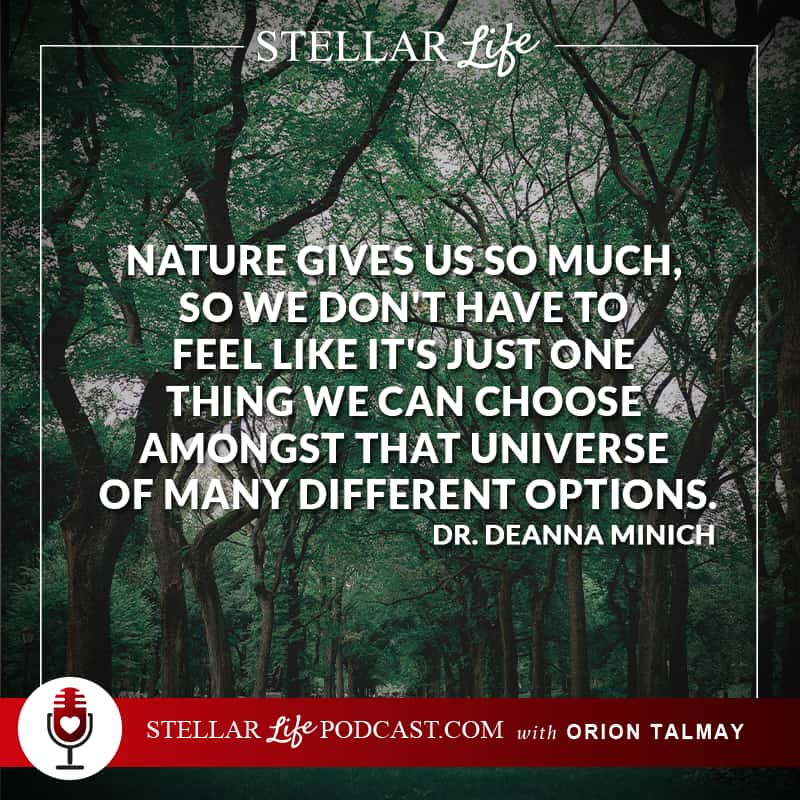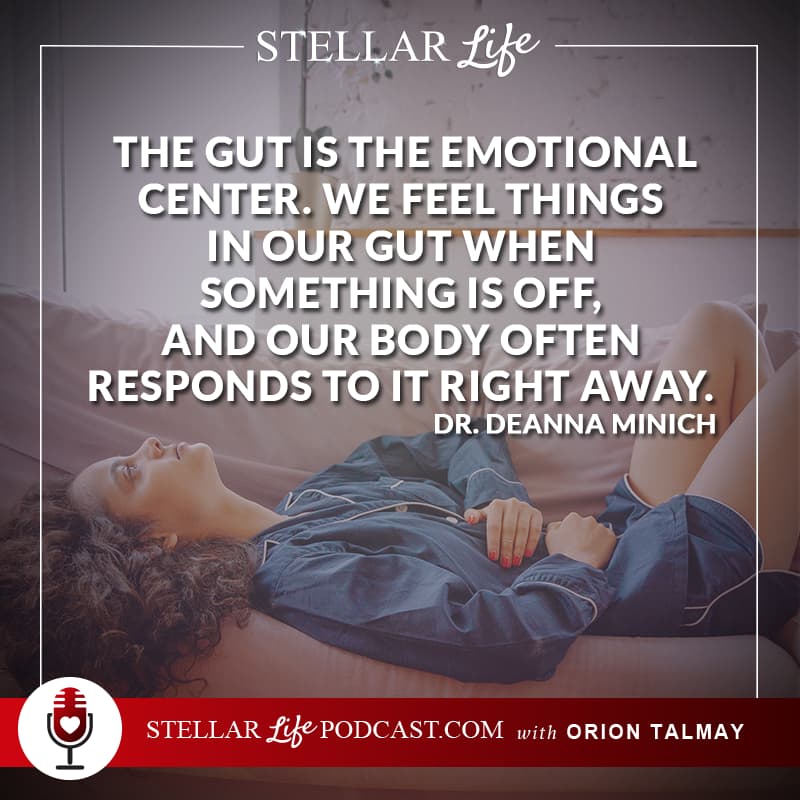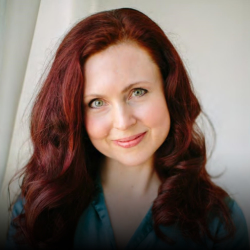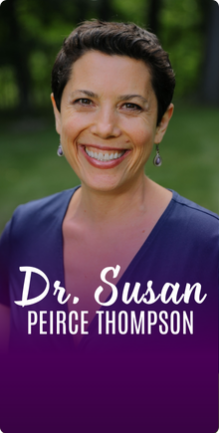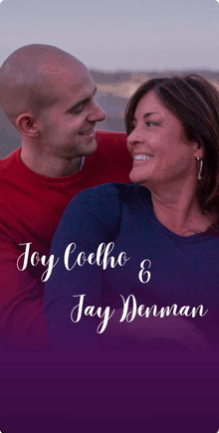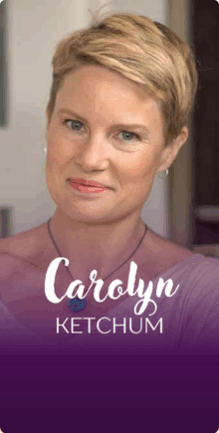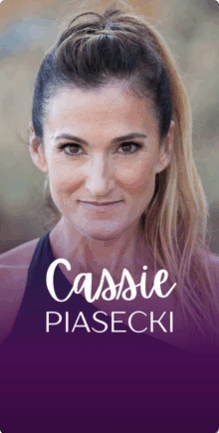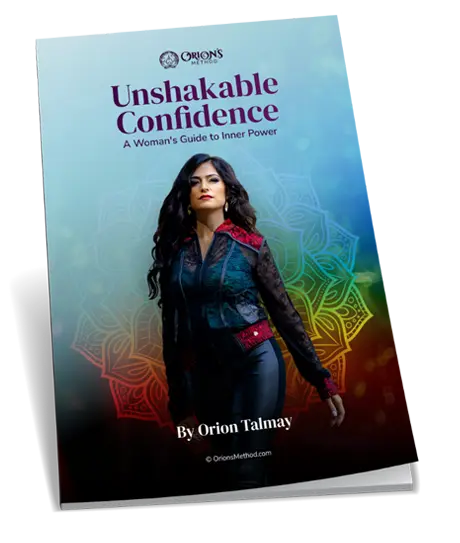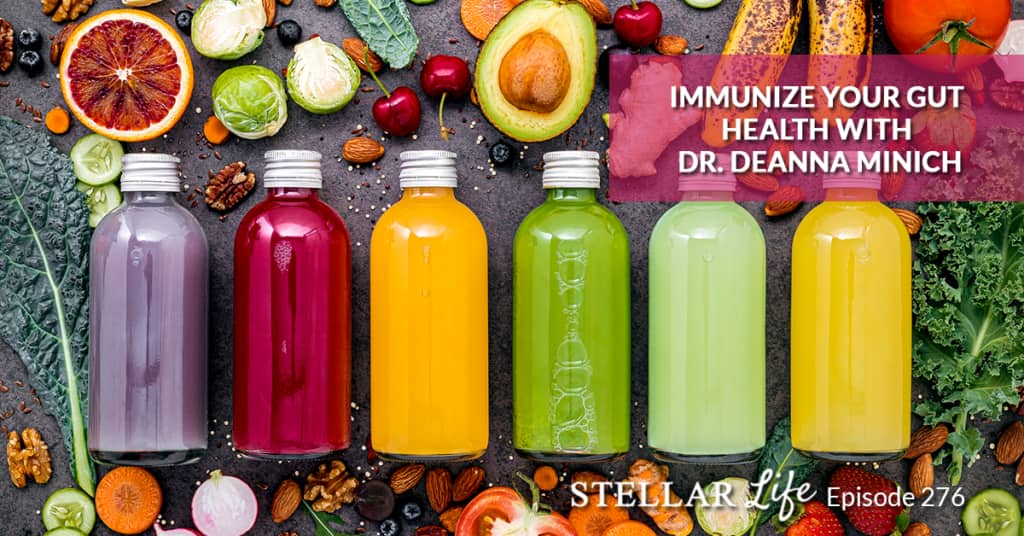
In this Episode
- [01:16] Orion introduces Dr. Deanna Minich, a health educator and author with more than twenty years of experience in nutrition, mind-body health, and functional medicine.
- [03:01] Deanna shares the beginnings of discovering her passion.
- [07:06] Orion wants to know the correlation between gut and stress and the connection between gut and brain.
- [08:51] Deanna explains the solutions and steps on working on stress and healing emotions.
- [12:00] Deanna talks about the importance of having a rainbow diet, emphasizes that each color symbolizes a certain functional benefit, and starts discussing red-colored foods.
- [14:20] The representation, examples and benefits of orange and yellow-colored foods as explained by Deanna
- [19:57] Deanna talks about Green colored food is for the cardiovascular system and further explains the vitamins and nutrients found in it.
- [22:25] Deanna explains that blue-purple-colored foods contain compounds that travel to the brain for specific roles and functionality in learning and memory.
- [28:33] Orion asks more about colors, wearing colors and how it affects different parts of life.
- [35:29] Orion wants to shift the discussion and talk more about emotional eating.
- [37:54] The three steps to address emotional eating as discussed by Deanna
- [40:58] Orion and Deanna discuss the alternatives for expressing emotion and the importance of having inspiration in life.
- [46:01] Visit Dr. Deanna Minich’s website to know more about how to start your journey towards good health and full of energy.
- [46:23] Deanna shares her three tips for a stellar life.
About Today’s Show
Hi, Deanna. Welcome to Stellar Life podcast. Thank you so much for being here. I am super excited to talk to you and learn so much from you. Before we begin, can you tell me how you discovered your passion? And what you do today?
Yes, I would say that my mom is the one that got me going down the path of food and nutrition. Early in my life, she was tuned into health and healing and her faith. I think she combined those things in a very unique way. And that set the stage for my teenage years; I got into science.
When I went to the university, I was very interested in science, but I wanted to think out of the box more. So I got interested in English literature, art history, yoga. I began to open my horizons a bit more. Then, I went to graduate school to study nutrition because I got more interested in food. And I went for my master’s and my Ph.D., all within nutrition science and medical science, and emerged from that womb of academia when I was about close to 30.
I had a particular passion for plants, plant foods, and the nutrition of plants.
Then I went into the working world, but I had a particular passion for plants, plant foods, and the nutrition of plants. There were a lot of common threads coming together like art – I started to do paintings on my own, just abstract art and lots of hyper color type of imagery. I think all of us in the health field, in some way, shape, or form, much of our path will start with our own healing.
For me, it was a personal healing process where I had a number of issues, and I continued to look for solutions. Many of those solutions were multifactorial: food, energy medicine, art, massage, and acupuncture.
Nice. I’m passionate about gut health, especially lately. About a month and a half ago, I bought a jar of kimchi from Whole Foods. I like kimchi. When I lived in Japan, I had Korean friends who invited me over; I’ve been eating kimchi my whole life. I never had a problem. And then I took a bite of that thing and got the most horrible food poisoning for 24-hours and started throwing up, and I won’t bore you with the details.
Since then, there has been something that has happened with my gut health. There were stomachaches, bloating, and so much freaking pain from that day on. Now it’s getting better. I’m doing celery juice every morning, and that helps. I took some medicine for that. But I’m still under the doctor’s care.
Stress changes the flow and the fluidity of the gut.
And I heard you and one of your talks about the relationship between the gut and stress in your life. So how does that correlate? Because I know that I had a lot of stress that happened. Two days before my mom left. She stayed with us. She’s from Israel. She stayed with us for six months. So two days before she left, it happened. Obviously, there is some stress connection there.
Surprise, right. I think it’s one of the underestimated aspects of our gut health is stressed. Many people think, “Oh, it’s the foods that I’m eating.” It can be the food; the food can be a trigger. But stress changes the flow and the fluidity of the gut. The motility – how it moves; it changes the secretions like the pancreatic enzymes and the acid. It can change the gut microbiome, and if you change your gut microbiome, it changes a whole bunch of different things. So it’s been well recognized.
In ancient traditions, the gut is like this emotional center. Like, we feel things in our gut when things are off. It’s been said that the gut is the seat of intuition. I don’t know if that’s necessarily the case, but I know that the gut responds. For example, our bowel movement changes if we are stressed, nervous or, anxious about something. So I think that the gut is a portal to our physiology, body, mind, emotions, and psychology.
Right. What is the connection between the gut and the brain? How do they work together?
The gut is the seat of intuition. It's a portal to our minds. Share on XMany of the neurons in the body are located down below in the torso. A lot of these afferent neurons gather information and take it up to the brain to process so that we have a response or a signal. In addition, separate from the neurons, we produce a lot of these signaling molecules in the gut like neuropeptides, a lot of these very active proteins that get produced in the gut and then travel systemically to interact with our brain. They cross the blood-brain barrier, and they have some effect there.
It’s also been said and shown that we produce neurotransmitters in the gut, like dopamine and serotonin. A lot of these things that we would consider to have neuroactive psychoactive properties in the brain, we’re producing most of them in the majority in the gut. So the gut is, I would call it, a psycho-neuro-endocrine immune organ. It houses the psyche, the nervous system, harbors a lot of endocrine function, responds to hormones, and 60 to 70% of our immune system is located in the gut. So it’s a huge hub.
No wonder so many people are fascinated with the gut. And we’re now starting to appreciate the gut. And I think it’s a portal, it’s a portal to the outside world going in, and going out, right. It’s a tube that connects us to the outside. So I think from that perspective, it’s very intriguing. It’s doing a lot of things.
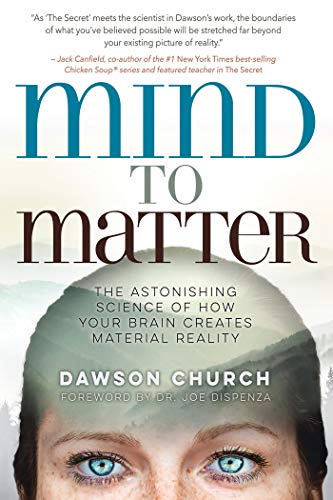
What is the solution? You go first to food and heal the gut through food, and you were talking about the rainbow diet. Or do you go to mindset or healing emotions? What comes first? What do you do about that?
I asked the person, what do you want to do? Because all paths go up that mountain of healing. Working on stress can be as effective as changing your diet. Maybe there’s just one thing about food that you want to change, and you say, “Well, I can do this, or I can do that.” Oftentimes, what I have found clinically is that we most feel like we want to hang on to and not give up is the thing that we most need to give up. Some of these are dysfunctional; let’s take food as an example. I’m a nutrition scientist, so I typically think about food as my first-line approach.
However, food is not everything. Some people eat healthily, and they get stressed out about it. They’re orthorexic; they’re so focused on eating healthy that it’s a whole stress-filled process. So that’s not so good for the gut. Do we want to create a leaky gut just through our thoughts about healthy food? No. I would say all paths are valid. If we are focused on sleep, we’re focused on physical activity, we’re focused on food, we’re focused on better relationships and relaxation in our lives. It’s all relevant. These are all many paths up that road of gut healing, for sure.
When somebody is coming to you, what will be the first step?
Well, people know me for food and eating. They know me for nutrition. They know that that’s what my professional background is about.
And within this round, what will be the first thing you would do?
Working on stress can be as effective as changing your diet.
Well, I would ask them how they’re eating. Typically, I like to see photographs because a photo can tell us so much about the quality and quantity of food; it’ll let me know about their colors. What colors are taken in? Are they taking in a lot of processed foods? It’ll tell me about the combinations of foods. And from there, I can ask specific questions.
If I see that somebody has a lot of brown, yellow, and white on their plate, so brown meaning like a lot, and by the way, I’m not wedded to a certain dietary dogma. It’s not like I say, “Everybody has to be vegan.” “Everybody needs to be an omnivore, or paleo, or keto.” Well, what do you know? I’m not trying to shuffle everybody into that direction.
I would like to see people eating more plants. Plants in general. We can pick the kind of plants we want. It could be herbal tea. It could be spices. It could be herbs from the garden. It could be fruits. It could be veggies. It could be grains or legumes. Nature gives us so much, so we don’t have to feel like it’s just one thing we can choose amongst that universe of many different options.
Right. When you see people like the color on the plate, what do the colors represent? Why do we need color? Why do we need to eat the rainbow?
so let’s go through each of the colors because each of them symbolizes a certain functional benefit or a signature in my mind. So the first one is red. If we think of the rainbow, let’s just do five colors. So red is the color of urgency, emergency, reactivity, survival. Typically, we see red foods, like cranberries, strawberries and tomatoes, and so many different beets, so many different veggies, and fruits. We tend to think that those foods address inflammation, and they’re addressing the immune response because immunity is connected to the inflammatory response. There are certain plant compounds that help reduce that noise in the body.
I would like to see people eating more plants.
Now, that doesn’t mean that all the other colors don’t do that. But red foods, in general, seem to have a little bit more activity, or at least I see a pattern around that. So red is important for that. And as you can imagine, inflammation is connected to heart disease; we see some research on prostate health in men. So looking at red, like pomegranate, watermelon. In fact, I was looking at a study on watermelon and how watermelon contains different compounds that help open up the blood vessels. So it causes the expansion of the vasculature because it helps to work on things like inflammation.
I was devastated because I just did the Biome test. And one of the things they told me not to eat is tomatoes, watermelons, and peppers, like three things that I really love. I have no control.
Right, and that can happen temporarily, so red is also the color that can evoke inflammation. So for some people like you, “I can’t do tomatoes. I become red. I have more histamine. I have more pain. So I have to pay attention there.” There are certain red foods like chili peppers and strawberries. Tomatoes can lead to inflammation in some people. So there can be a case that it could either lead to inflammation or stop inflammation. Sometimes we have to take those things out temporarily and reset the body, and then we can see them again.
Yeah, for sure. So that was red. What’s the next color?
That’s right. The next one is orange. We think of fruits. I think of circles like mandarins, oranges, persimmons, peaches, mangoes, and papaya. Gosh, so many good things. Lately, I’ve been fixated on mango. Dried organic mango is good.
We have a mango tree in our backyard, and we had two months of so many mangoes. I still have frozen mangoes.
Lucky you!
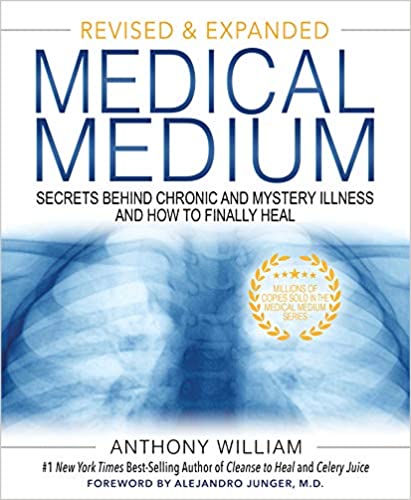
Anthony William
Oh my god, so many mangoes I’ve ever had in my life. And then I went to my acupuncturist, and it’s like, “Mango, it’s not good. It’s like cheese for your body.” It’s like the cheese of fruit. I disagreed with him.
One person’s medicine. It can be another person’s poison. It just depends on your body and maybe with your constitution. Perhaps he was seeing something about the mango being not so good.
Well, he said that mangoes are more easily digested by younger people. And now that you’re not as young.
I don’t understand that. Mango has natural enzymes as well. There are things within a mango that could help with digestion. The only thing I think people have to think about with mango, especially dehydrated like I’ve been eating, is that it could be high glycemic. It’s a lot of sugar that we take in all at once, if we don’t take it in with other things.
But in general, mango is high in a carotenoid called Beta Crypto Xanthan. Beta Crypto Xanthan and other carotenoids can be beneficial for reproductive health. Some of the signs that I’ve seen on Beta Crypto Xanthan suggest that it would play a role in reproductive issues. It can help us because those carotenoids can be protected in the body in whole food formats.
Yeah, it’s good for fertility.
Yeah. So orange is the color. It’s a warm, sexy color. It’s inviting; it’s playful. In the animal kingdom, it was really interesting; I’m no animal scientist.
If you look at the chakra, the orange chakra is around the reproductive systems that make sense.
Yeah, you see the trend, aren’t you?
I see the trend. I’m connecting the dots.
Nature gives us so much, so we don't have to feel like it's just one thing we can choose amongst that universe of many different options. Share on XI don’t talk chakras with everybody. But when people start to hear of the associations, they say, “Oh, wow, I see the chakra signature here.” And it’s like, “Yes,” but I try to make this accessible for more people because I want more people to receive the truth of that particular those findings.
Anyway, orange is playful, reproductive, and protective. But even think of like in nature, when fish like guppies want to mate, the female will be most attracted to the bright orange male. In nature, like I even think of ducks, how the male has certain colors. Those colors are connected to these plant compounds.
So even though it’s not like the female is thinking, “Oh, I want a mate that will be good in surviving and give my offspring a better chance of survival. So let me pick the most colorful one.” It’s just that nature has that kind of built-in that the color of the plumage or the gills of the fish corresponds to the pigments from these carotenoids that are good for reproductive health. So it all worked out.
Cool. So after orange, we got?
Yellow.
Yellow.
Don’t forget blue-purple everybody. Because we need those compounds for the brain.
Yellow is the fire element up in the digestive tract. Banana is a high prebiotic fiber. If we go with a less ripe banana, we can get a lot of fiber in the banana. Banana is also really high in serotonin.
Is it better to eat like a ripe banana or a young banana?
It just depends on what you want from the banana. If you want more fibers, I would say to choose a less ripe banana. Like a more green banana. Have you seen the green banana flour that’s available that people can buy now?
No, I haven’t.
Yeah, green banana has been talked about for its prebiotic effects. People are using it for baking and different kinds of applications like smoothies. It’s very good in a variety of different prebiotic effects. It gives us the substrate or the fiber for good bacteria to work on in the gut. So there’s banana, there’s lemon, there’s pineapple, there’s plantain, there’s ginger.
A lot of these things are very catalytic. Maybe they’re red thing the digestive fire, so to speak, or they’re changing up bile flow, and bile is yellow. It’s that yellow-green. The liver is fueled by some of these different compounds. The pancreas is helped by some of those enzymes in pineapple. Pineapple is filled with bromelain, which can help digest our foods.
It’s also great with coughs and flu.
Yeah. It reacts, breaks down protein, and breaks down a lot of those inflammatory compounds. Like when we have an injury or cold, flu people take proteolytic enzymes to help break down those different proteins.
Nice. I want a pineapple right now. I’m going to shop in Whole Foods right now.
Cool. So that was yellow. What else is good? What else are we talking about?
Green.
Green. Of course. Green is up in the heart. Green is all about the cardiovascular system. It’s all about giving the heart what it needs. If you look at a leaf of kale, you can almost see the vasculature. You can see all those highways and networks of like veins of the plant. And that to me that’s like the doctrine of signatures, and what we know about leafy greens is that they’re high in folate. They’re high in Vitamin K and Vitamin K phylloquinone, and they’re also high in nitrates – healthy nitrates that convert in the body to nitric oxide, which open up the blood vessel.
If you need more stimulation, you need more inspiration and motivation.
All in all, those greens are good for the heart. Whenever I think of green, that’s like the color that’s most widely found in nature. It’s not orange or yellow. It’s green. Green is everywhere. There are many green choices, whether it’s leafy greens, different types of onions, or different cruciferous vegetable families like brussel sprouts and broccoli. There are many different things that we could choose from.
Do you juice a lot?
I don’t; I juice in season. So I live in the Pacific Northwest. So it’s rainy and cold in the winter months. I also go with the energetics of food. I’m married to an acupuncturist, and I come from thinking about the energetics of food as well as the science of food.
In the winter months, my body doesn’t feel like cooling juices; I feel like warm teas and other types of more soothing elements. But in the summer, oftentimes, I will make fresh juice. I have a juicer at home. So I’m able to do that. But I prefer smoothies over juices because I think that getting the fiber from the fruit or the vegetable is important for how that food is assimilated in the body.
Yeah, I live in Florida, so I can juice the year.
Yeah, it’s warm where you’re at now.
Yeah, warm. I’m wearing long sleeves, but I can wear a t-shirt as well.
Exactly.
So color in different aspects of our lives. You said that the food that we eat, they give us something. So we always want to have the rainbow on our plate. So how does color affect other aspects of our life?
We can’t separate our food from our lives
Well, the only other thing, let’s just cover blue-purple as last.
Of course. Yeah.
I don’t want to leave that one out because that’s the one that most people don’t get. So it’s interesting that we left it out there because that’s what happens in the American diet. People leave out blue-purple. It’s a rare color.
I just did that. I feel ashamed.
Well, no, it was symbolic. It was symbolic that you did. It’s great. It shows how we don’t tend to think of blue-purple. But blue-purple is out there. And in fact, many of the blue-purple foods like berries and grapes, and even purple varieties of foods that aren’t normally purple, like purple kale, purple Brussel sprouts, purple broccoli, all those kinds of things, purple shades of leafy greens of various types, that purple compound is really important for the brain.
In fact, some of the earlier work would suggest that those purple compounds would travel in the body to make their way into the brain for certain roles and functionality and learning and memory. So learning memory, these are the anthocyanins compounds that make that food very purple and pretty. And you had some questions about the gut. Many of these purple-ish compounds are considered to be in the polyphenol category.
Many of your listeners may have heard about polyphenols; polyphenols are used by gut microorganisms. They metabolize these plant compounds, the polyphenols, and then make more active compounds that help the body overall. So blue-purple is for the brain, don’t forget blue-purple everybody. Because we need those compounds for the brain and otherwise.
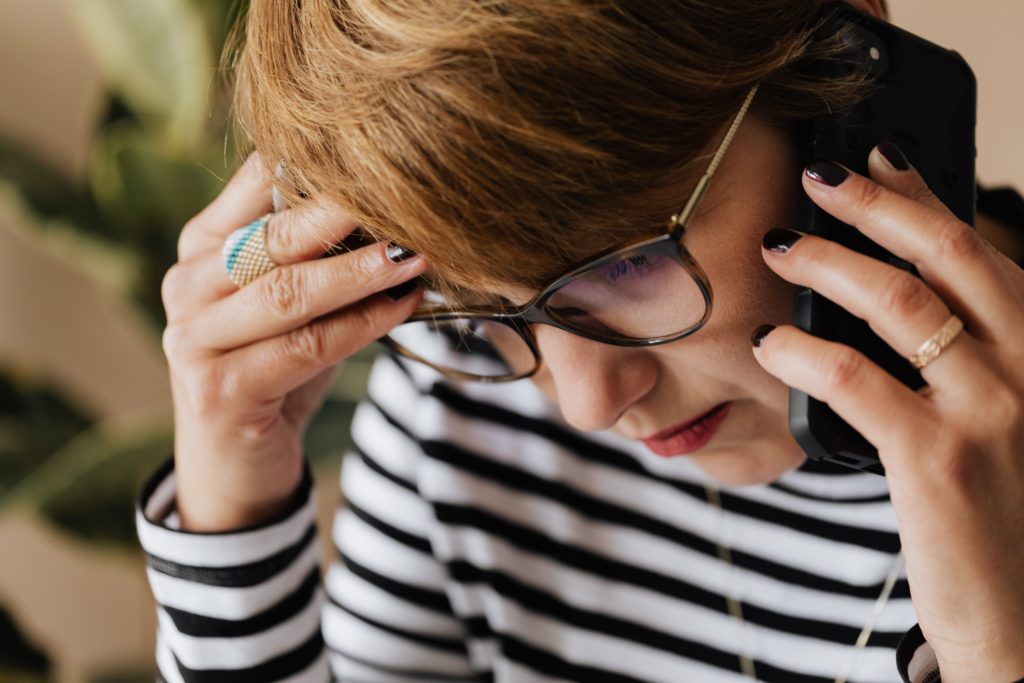
And then I’ll just say a quick word about brown, coffee, cocoa, chocolate. Oftentimes, these things are considered taboo for various reasons, mostly caffeine. However, they do contain important phytochemicals. Cocoa and chocolate, the dark chocolate variety, both of those things do contain polyphenols which can be helpful for the gut. Unless somebody’s sensitive to caffeine. You don’t want sugar in those products. That’s not so good either.
But the pure cocoa, if people can get raw cacao, what I liked to do in the winter months is take—or you could even try this in the summer—raw cacao powder organic. You get it at the store in powdered form. You take just a big heaping tablespoon, put it in a coffee cup or a mug, put hot water, and stir it, put some cinnamon and perhaps some other spices, and it tastes so good just like that.
That’s my morning coffee, actually organic raw cacao with cinnamon and a scoop of collagen protein and almond milk. That’s what I do.
That is perfect, and then you even brought in the white. So you brought in the collagen powder, and for some people, they look at coconut, MCTs, coconut milk, coconut variety.
Long term, it’s healthier if we can figure out the emotional strategies to express in healthy ways.
In the last couple of weeks, I have to admit that I’ve changed it into more celery juice than cacao because somehow, I don’t know what is in it. It doesn’t taste good. It’s kind of salty, tasteless. But it just when I drink it, I feel like it’s healing the system, and I feel very different, and I started to do a glass of water with one lemon. I took that suggestion from the book, Medical Medium.
I have the book here. Also, this book Mind to Matter is fascinating. These are the books that I’m reading right now from a friend of mine. And so he recommended to do this and then do celery juice. And then you do a detox shake with cilantro, which I didn’t get to. I was like, “Okay, I’m just gonna start adding things and baby steps.”
I’m glad you said that. Because I think many people go all in, and then they start doing so many things all at once. And then comes a problem because you don’t know what changed “what.” Was it the combination? Or was it one of those things? So it’s good that you’re doing it stepwise.
I like that. It’s really helpful. And I did a brain scan with Dr. Amen five years ago. One of the things that he recommends for the brain is blueberries. So almost every day, I tried to have some; I didn’t know it was purple. I don’t know why; they’re rich in antioxidants, they’re low glycemic, and they’re good for you. So this is one of my staple foods. Definitely.
That’s a great blue-purple for the brain. Absolutely. They’re doing a lot of different things even beyond just being an antioxidant.
What else do they do?
They’re protecting the DNA. They’re anti-glycated. They also change the properties of the neurons. So they’re helping with neuronal growth. Some animal and cell studies are looking at what’s called Brain-Derived Neurotrophic Factor (BDNF), a compound that can be used for the growth of neurons. And it seems like blueberries, at least in cell models, from what I’ve seen, may help with neuronal growth, so it may prevent unwanted cell death.
Feed that rebel because the rebel is you.
We used to talk about foods like fruits and vegetables being antioxidants. But now I think we’re becoming more sophisticated because we understand that food is complex, it has a lot of different things in it. And those things sometimes play a role locally, sometimes systemically. In the case of blueberries, I think it’s more like a system-wide effect, especially since I’m seeing more research on the brain.
So I want to ask you more about colors, and how it affects different parts of our life. Like when you wear color, what does it do to you? Or what’s your research around color?
Yeah, well, color is important. I would say it’s an environmental signal that changes our behavior. For example, if you see a red stop sign, we know to stop. If you see a red stoplight, we stop. Ambulances are red. If we’re around cooling colors, like green, blue, purple, we tend to feel more relaxed than when we’re around red, orange, and yellow, which are more stimulating and more warming. So I think that color science, color psychology, and color therapy acknowledge and recognize that.
There isn’t a lot around here having certain colors and then just like monitoring mood states and how rapidly that could change because I think that we feel like much of what I’ve seen has been more intuitive rather than science-based. It’s a more soft science. How do you feel when you see this color?
That said, we also see a lot of use of certain colors in marketing. The color blue, like a deeper blue, signifies authority or some type of credibility. And you’ll find that blue is often used in science and different organizations to impart a tone of more credibility.
Green is associated with health. So typically, a lot of healthy food products tend to be green or use green packaging, green letters. Even health practitioners many times will use green in their business because it imparts some kind of feeling of like, “Oh, there’s something healthy or something about nature with this particular business or product.”
When I’m in a really good mood, I wear more color. When I feel more playful or powerful, I wear bolder colors.

And I think it can work the other way to where you can change your mood based on the colors you wear. You can try that. My wardrobe is laid out in the rainbow.
Really? Wow.
And when I get out, it just makes it easier to organize. So I have my red. I have the full spectrum. I have black and brown at the end. But I do kind of sense the day, like I have to pack for a trip this weekend, or this week, actually, I leave tomorrow. And I was feeling like, what is the feeling I want for this trip? And I thought I need green. So I went, and I got. But you see, I thought about it intentionally like this is the color that I want. I want to bring more healing, more love compassion to this whole visit.
Some visits are more, I would say business-oriented, and they don’t have that same. So I’ll pack more like blue, or even black, or beige, or more neutral tones. But I do think about it. And I do believe, at least for me, that the color that I’m wearing is changing my perception because I’m constantly seeing it. And everything carries a wavelength. It’s a light, it’s being registered by our eyes, and our eyes are essentially part of our brain. And so we’re getting a quick signal as to our associations with that color.
If we have a negative association with a color, we could be stimulating that too. And so often I’ll ask people, what’s your favorite color? And what color do you avoid? So that could change for everybody. I know for me since I was very young, I always like the color green, kind of like the green that’s in the back of you, it’s all perhaps a little bit deeper, like a forest green. So I’ve always loved that color green.
Change it up, get out of your rut.
The color that I haven’t liked is orange. I struggled with the color orange and especially pink, but now I work orange and pink all the time. I don’t know what happened to me, but it’s like, I’m in a pink phase. In fact, just today, I asked myself what happened to me? I went from not liking pink at all—especially the pastel pink, like the lighter pink. I would never wear it. Never, never never. And then all of a sudden, like I can’t get enough pink. I can’t get enough of that Jason Momoa’s light pink color that he always wears. I was wearing a pink sweater just before now.
When it comes to Jason, I don’t know if it’s the color I’m looking at.
I don’t know either. I mean, that’s a tough one. But the two together is like a one-two punch, right? It’s like, whoa.
That’s cool. And now I want to go shopping, not at Whole Foods, to buy more color. Lately, I was looking at my wardrobe, and I’m like, it’s kind of boring. I want to have more color in my life.
If you need more stimulation, you need more inspiration and motivation. I would choose red, orange, and yellow. If you need a cooling off and relax, you need more calming vibes around you. I would say go with green, blue and purple. And if you need more neutrality, just like where you are, kind of like you don’t want energy in either direction. White, black, brown, navy blue, beige, like the more neutral tones. You can fire yourself up psychologically through those warming colors; you can cool yourself down.
Sometimes, I wonder whether or not people are showing what’s going on on the inside. I made just an anecdotal correlation with a couple of clients that I noticed when they were very inflamed and wore a lot of red. And I was thinking is there a correlation between them being inflamed on the inside and showing that inflammation through red lipstick, red sweaters, dyeing their hair red, all the many things of red and orange.
My mom always told me that if I’m sick, I should wear red. She didn’t give me an explanation why. If you’re sick, wear red. And I noticed that, I don’t know because she told me, but when I’m not feeling well, I gravitate to red. Or when I wanted to look really sexy, I grabbed a red.
If you need more stimulation, you need more inspiration and motivation. Share on X
Yeah. Red is attention; it’s action. I can see why your mom would say that it inspires us to get engaged because it denotes some reaction or activity. And then you probably have heard like, if you go on a job interview, wear your red power suit.
Really?
Yeah, wear red.
I would think that it would be alarming to the other side.
Well, maybe in this day and age, it’s a little bit different. But I think historically, there’s been discussion about wearing red for attention. Red can also be a passionate color. Like Valentine’s Day, red hearts, and just bringing out a lot of feeling or emotion. So there’s that.
That’s cool. That was very interesting and wonderful. And I want to shift and talk a little bit about emotional eating. I do this because I like salty, and I like sweets. And they like me too.
I would say about emotional eating that most people do engage in emotional eating; we can’t separate our food from our lives, right? I mean, food is part of how we live and how we live; it’s how we eat they’re integrated. With emotions, I would say that we’re often not expressing the emotion, so we tend to eat to compensate. I think it’s been estimated that over 75% of overeating is due to emotions. But people don’t recognize that it’s the emotions that are the driver.
So I would say to be in touch with emotions, do an emotion log and a checklist. Take note if you feel more sad, depressed, bored. Boredom can lead to more emotional bouts of eating to take up and fill the space with something – people sometimes will eat. And that’s considered as part of emotional eating.
Why are we eating? I think we need to ask “why.” Are we feeling hungry? Are we bored? Are we eating comfort? And so many times, just like you said, if we want salty or sweets, many times the flavor that we’re going for that taste, that sensation mirrors what we’re feeling, or it connects to, in some way, a sense of comfort or a memory, or an experience around that food.
Right. And I heard in one of your talks that you mentioned that fatty foods help with sadness?
Colors play a huge part in our lives. It often depicts our way of thinking, mood, and even health. Share on X
That’s true. That’s not my work. That was something in the literature where an infusion of fat helped to, in this particular study helped with overcoming feelings of sadness. So then I often think when people are sad, maybe they go to ice cream, or things that are high fat, as a way of like, numbing, right? We bring in, dissipate, or clear, but the food is only a temporary fix. And I think long term, it’s healthier if we can figure out the emotional strategies to express in healthy ways.
Alright, let’s talk emotional strategies. Because sometimes we have the awareness and like, I’m sitting, I’m eating the chips. I know it’s not good for me. I’m like, whatever. I’m just going to keep going. Keep giving it because I’m not feeling that great right now. All right, I’ll eat something from my childhood because it gives me this connection to something. Something in my past or food equals love equals family equals good memories. So I’m going to have this now to feel more elevated. So what are some of the strategies you have to share with us?
Yes, okay. I think about it in three steps. The first step is to become aware. You already said that even if you’re eating the chips, you’re thinking, “Oh my gosh, you know, I’m doing this; it’s not healthy.” So you’re at least aware. That’s the first part of this whole thing is to know when you’re emotionally right.
I’m aware that I’m self-sabotaging right now. And then the rebel side of me that said, “Okay, whatever you deserve it, or just now or just today.”
Well, feed that rebel because the rebel is you, and there is this peace of needing to accept. So how do you accept the rebel? Number two is to give the rebel an alternative, so there might be potato chips, but then I would say to make a list of all the many other strategies you like to engage in so that the rebel doesn’t go to potato chips. It’s like, “Okay, I could do this. I can go to a mall and go for a walk. I could go and do this. I can go and do that.” But give yourself options so that you have alternatives.
And then I think for people who are serious about getting to the root cause of their emotional eating, you’ve got to do the deeper work with somebody who’s trained in the art of looking at each of those foods and what they actually connect to emotionally and then finding strategies to allow those emotions to come out. I’ll give you an example. The reason why I got into art is because I had lots of emotions. And I realized later that I wasn’t expressing, and I didn’t know how to express them. And the only way that I felt called was to make art and to have lots of color on a canvas.
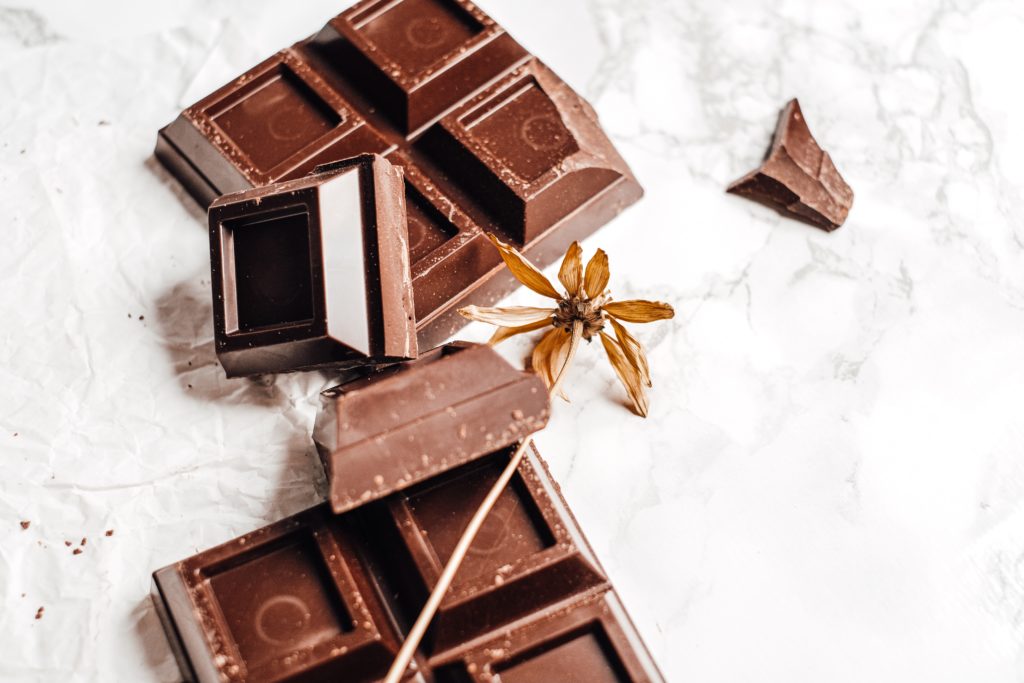
I want to see your art right now. Do you have it?
Gosh, our room is filled with my art. Well, I have one canvas here. I don’t know if you can see it.
Yeah, I can.
Yeah. So it is swirly. You know.
Very emotional.
That’s exactly right. And that’s where I let things come out because not all emotions can express in words, sometimes it will be color. And I usually paint in orange, pink and gold, which is really interesting. Those were the colors I don’t like. So here’s another one.
I feel like those colors represent sides of you that you weren’t willing to accept. And now you’re integrating. It’s part of self-acceptance.
Exactly, exactly. So I’m just showing that as part of really allowing people to see that there are alternatives for the expression of emotions that can be healthy and creative. For me, it just happened to be art. My husband is a musician. So he does acupuncture by day, music by night. That’s his release. That’s his stress valve that he can open, for other people could be dance, it could be hiking, it could be biking, it could be going to the gym. The gym would only cause me stress; I have no joy in the gym. I don’t get into that. But I like my creative time where I just turn on the music. Sometimes I listen to my husband playing the guitar, and I can start to go into my mind space of creating with color.
Nice. I discovered my love of painting, but only did two of them, and they were marvelous, and then I stopped. And now, you make me want to paint again. So you are inspiring me. Thank you. And I’m sure everybody that is listening. Now it’d be like, I’m going to buy a new wardrobe. I’m going to shop for good food. I’m going to paint, dance, hike, sing, express myself.
The gut is the emotional center. We feel things in our gut when something is off, and our body often responds to it right away. Share on X
Because we deprive ourselves like we put ourselves in cages, we deprive ourselves of things that make us feel good, because we have to focus on our careers or put all those rules around ourselves. And when you start doing stuff like art or singing, or anything creative, you affect your brain, break through those boundaries, and expand who you are. And you’re fulfilling more of your true potential. And then you end up wearing pink and feeling amazing.
You nailed it. Sometimes, we need that inspiration. I’m glad that I found that path of using art to express my emotions. It’s not like I use art all the time; sometimes, I like to be in nature. We need other options. I have a rebel side as well. I think all of us have a rebel archetype. We’ve got that resist kind of that teenager mentality. And it’s like, that’s okay. I mean, let it out. Let’s get it out on paper. Maybe we make poems; we make prose; we do haiku. I had one woman in my group who did haiku. That was her form of emotional expression and how she identified herself.
Okay, let’s say it’s the middle of the night. Actually, I don’t eat in the middle of the night. So let’s say it’s the evening, and I’m craving that piece of chocolate. And I’m trying to grab the piece of chocolate. How can I convince myself to go and do something else because grabbing the chocolate is so much easier than going to the gym or taking all your art supplies and starting to create? Or maybe you create when you’re not feeling emotional, and then you have the outlet, and then you don’t have the craving.
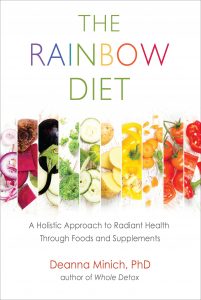
All of the above. Because then you get rid of that buildup of emotion. I don’t paint every day. Oftentimes, I’ll paint like twice a month, and it releases kind of like all of that stuff that has been accruing and stagnation. It’s like a good acupuncture treatment. I find that acupuncture is great for releasing stagnation, emotional stagnation, because I don’t have a lot of physical symptoms. Still, I sometimes feel tension or it’s all emotional for me. So acupuncture does that, painting does that.
So what do you do at night? Some of my strategies would be, number one, do things you enjoy. So like taking a hot bath, I have certain songs, or I try to like turn off the mind by doing things that are more, I would say, allow me to be in the space of openness. Like listening to different music that I like 15, I’m sure you’ve heard of the 15 minutes wait out where we can distract ourselves from some craving if we can move away from it and change our neurons within.
That’s easy if you’re not an Aries.
I mean, that’s fire and move it. Aries needs to burn, and if it’s fire, and it’s kind of like self-perpetuating, finding a way to spark that flame.
Yes, of course. And I’m joking, of course, we can take at least a few deep breaths, and just separate ourselves from the emotion, and there are so many beautiful tactics, and I want to like I can’t believe you’re already at the top of the hour, and I am. I want to be respectful of your time. So I have two questions. One, where can people find you, get your books, work with you? And two, what are your three top tips to living a stellar life?
All right, easy. The first answer to your question about where people can find me. They can find me through my website, deannaminich.com. So I have an Instagram page, I have Facebook. I have a Facebook group called Nourish Your Whole Self that people can join. I give lots of different tips and things on there.
And as far as the three tips, they are color, creativity, and variety. So with color, we talked a lot about color already. So bringing more color into your life. When we eat colorful foods, we have colorful moods, we live a more colorful life. Number two, creativity which allows us to express and provide a vehicle for healing with our emotions and so many other things. And then the third thing is variety. Change it up, get out of your rut; sometimes we get bored, and we get stagnant and stuck because we’re in ruts and grooves, and we’re in a ditch in our life where we can’t get out. And so to make a small shift in the direction of doing something new and different. Those would be my three tips.
Beautiful. Deanna, it was a pleasure talking to you. Thank you so much for this fun and very awesome conversation. I learned a lot. I feel very inspired by you. And I appreciate you being here.
Thank you, Orion. My pleasure. Thanks for your invitation.
Thank you. And thank you, listeners. Remember to live in color, embrace your creativity, and change it up, get some variety in your life and have a stellar life. This is Orion til next time.
